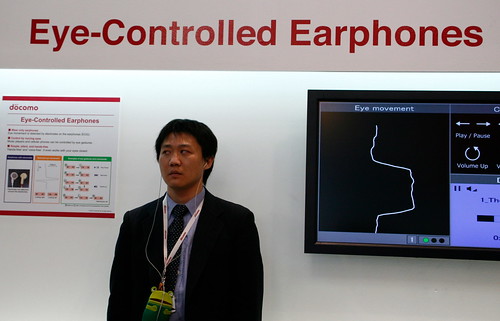
Leave it to the Japanese. I’ve speculated before about what kind of creative sensors you could load in to a mobile device. How about headphones that pick up the tiny electrical impulses emitted by your facial muscles when you move your eyes?
Here is a live demo of a Docomo volunteer controlling a cell phone music player with “eye gestures”. Look right twice to fast forward, roll your eyes clockwise to increase volume. Perhaps inadvertently totally shuffle your music collection if two unusually pretty girls/boys happen to walk by in opposite directions…
Above this man’s left shoulder you can see a line showing the live eye-tracking direction as well as a few of the gestures.
So perhaps you yourself will not want to ever look [literally] this ridiculous in public. Nonetheless it appears that creativity is well alive in new mobile interaction possibilities.


